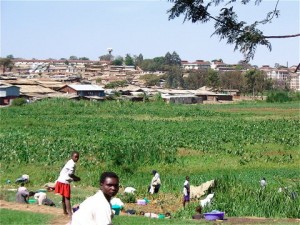I vividly remember just like it was yesterday when we use to go to the Nairobi Dam when we were young. We sometimes would wake up very early in the morning and meet with friends as we had planned the previous day. We would meet at a play ground near one of my friends house after breakfast and set off towards our destination.
After spending most of our time playing football, marbles and other ordinary games, we felt that we needed something different and this is what motivated us to go all the way to the east of Kibera. There was a lot going on there as people usually came in numbers. It was like a market place. Women who lived near would come with basins full of clothes and make use of the water which by then was clean and clear like crystal by washing their clothes and spread them to dry which took less than 30 minutes. On the other side of the river you could not fail to spot children swimming and others fishing from the clean water. This is one place which had different types of fish from Dagga, mudfish, catfish etc. It was a place of its kind in the heart of Nairobi.
Those days the Nairobi Dam was more than an attraction site. Unfortunately, heavy pollution emanating from the high-density population of the Kibera has stimulated growth of invasive plant species, especially Water Hyacinth which have infested the water body since and have curtailed recreational activities. Invasive aquatic weeds and solid waste dumping have completely altered the aquatic ecology and flow regimes of associated rivers.
Lack of proper waste management, solid waste and industrial waste is another problem. All the sewage contamination from the 13 villages of Kibera directed their waste into the Nairobi dam. This and other pollutants have rendered the water in the river system and the dam totally unusable and hazarous to human health.

The government had taken measures to restore the Nairobi dam an initiative brought into act by the now Prime Minister and Mp of Langata Hon. Raila odinga. But this is not meaniful as disposal of waste material from Kibera was not stopped. The aquatic weed and Hyacinth covering the Nairobi dam has brought in a new expansive land for planting of Sukuma wiki, arrow roots, tomatoes and bananas. The residents living near there have taken advantage of the then Nairobi Dam to put food in their stomachs.
Which to me sounds like a good idea.
Most plans to restore the dam have ended in futility. An example is the The Nairobi Dam Initiative in 2004 launched by the then Vice President of Kenya Hon. Moody Awori and sponsored by the United Nations Environment Programme (UNEP), the United Nations Human Settlements Programme (UN-HABITAT) and the United Nations Development Programme (UNDP). Farmers who have planted on the dam most of the time hinder its restoration fearing they will loss their produce which they claim its their source of living.

